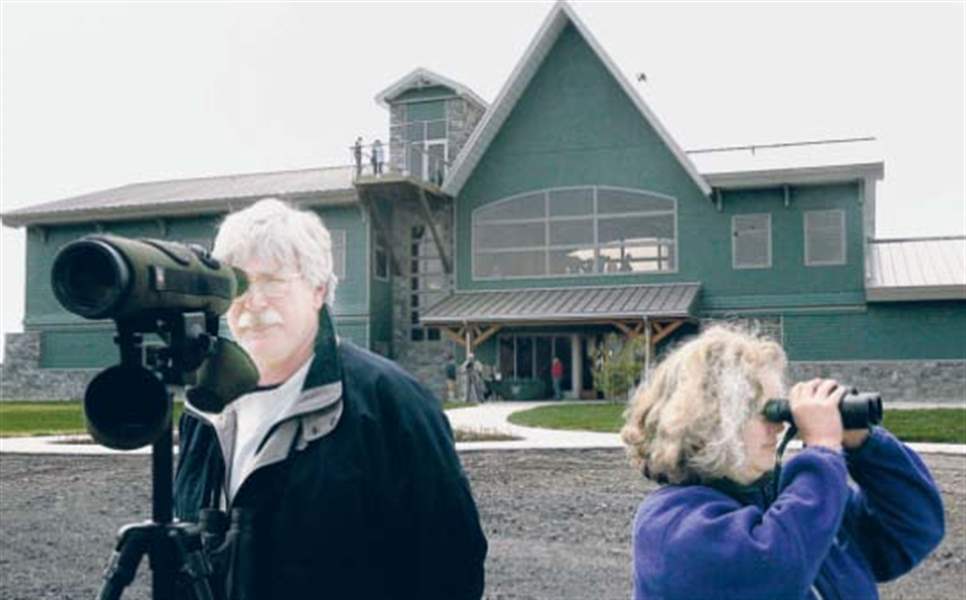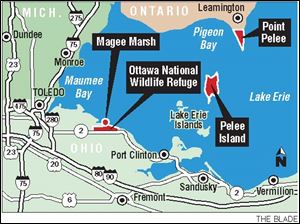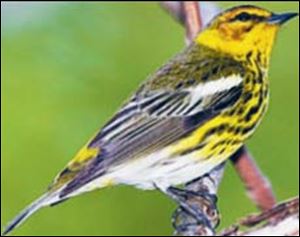
Thousands flock to northwest Ohio and southern Ontario for good view
7/6/2008
Visitors drawn to the Ottawa National Wildlife Refuge have included Olympia, Wash. s Tom Schooley and Sheila McCartan.

Visitors drawn to the Ottawa National Wildlife Refuge have included Olympia, Wash. s Tom Schooley and Sheila McCartan.
PELEE ISLAND, Ont. More than ever, North Americans are being lured outdoors by nature s super achievers of the sky.
Ones that scientists believe have flown above our heads for oh maybe 10,000 years or more.
We re talking, simply, about birds.
Tiny birds.
Migratory songbirds that winter as far south as Brazil and summer as far north as upper Canada s boreal forest.
From warblers to wrens and hummingbirds to orioles, migratory songbirds are so small you could easily hold six or eight of them at a time. Even more, perhaps, if you ve got big and steady hands.
Small, yes. But these birds have mighty hearts. And a ton of stamina.

With hot spots such as Ottawa National Wildlife Refuge and Pelee Island, birding is becoming a big business along Lake Erie.
Nature has drilled the urge to travel into their tiny brains.
Using the energy you might get from a Snickers bar, they go thousands of miles, marveled Lisa Petit, resource management chief for northeast Ohio s Cuyahoga Valley National Park, while speaking to a group of journalists recently on Canada s Pelee Island.
The miracle of migration was captured in an acclaimed 2003 documentary, Winged Migration.
Theater-goers were equally enthralled by the 2005 release March of the Penguins, which chronicled the migratory habits of Antarctica s emperor penguins.
It s absolutely huge
A lot of people are showing they have an urge to follow avian migration, whether they immerse themselves in the science behind it or not.

A Cape May warbler finds a perch at Magee Marsh.
Birding much of which relies on the thrill of finding birds on the move from one region to another has been one of North America s fastest-growing outdoor activities in recent years.
That s true for northwest Ohio, home to major bird flyways.
The area s Super Bowl for bird-watching, International Migratory Bird Day, is in mid-May. Thousands of binocular-toting tourists are drawn to Lucas, Ottawa, and Erie counties then, as well as the days leading up to it and succeeding it.
It s absolutely huge, said Melinda Huntley, executive director of Lake Erie Coastal Ohio, a nonprofit organization that promotes eco-tourism along Lake Erie s shoreline.
The bottom line
Research is under way to quantify birding s economic effects on northwest Ohio, she said.
A U.S. Fish and Wildlife Service study shows the Ottawa National Wildlife Refuge a collection of sites that comprise an incomplete sample of the region s viewing opportunities accounted for $3.5 million in expenditures in Lucas and Ottawa counties in 2006. Ninety-one percent of that, or $3.2 million, came from nonresidents.
Though a number of outdoor-related activities were examined, birding was the tops.
The refuge was lauded by readers of Birder s World magazine in 2002 as one of the country s Top 15 for viewing.
The northwest Ohio shoreline, including Magee Marsh, has drawn national acclaim from the American Bird Conservancy and the American Birding Association.
Mark Shieldcastle, wetlands project leader at Ohio s Crane Creek Wildlife Research Station in Ottawa County, said a comprehensive study of birding s economic impact in northwest Ohio was done in the mid 1990s and was pennies compared to what it is today.
It s just unbelievable the amount of people who come through here, he said, adding that he s observed roadways and parking lots are getting more crowded each year.
Hot viewing spots
Ohio gets the best viewing in the spring, when songbirds head north for the summer. Pelee Island and the Point Pelee National Park of Canada near Leamington, Ont., get the best viewing in the fall, when the birds head south for the winter, Mr. Shieldcastle said.
Area businesses apparently got an eye-opener from this year s turnout.
Kim Kaufman, education director of the nonprofit Black Swamp Bird Observatory, said her group made an impression about birding s potential among several Port Clinton businessmen.
First, it had thousands of birders turn in printed cards, about the size of business cards, to coffee shops, restaurants, motels, service stations, and other businesses they visited around International Migratory Bird Day. The cards said the holder had visited the area for its birding.
The group also took members of the business community on a bus ride to show them the number of vehicles parked along area roads and parking lots, allowing them to imagine the possibilities.
Birding could help some businesses expand their tourist season beyond the traditional Memorial Day-to-Labor Day period, she said.
They re starting to get the realization that birds can mean money, Mr. Shieldcastle said. That s the first step toward conservation, getting more support at the local level.
Charting the way
Ms. Huntley said she is working with the Ohio Department of Natural Resources and Audubon Ohio in developing a birding map, publication, and Web site for 2009 that will include an inventory of the top 61 birding sites along Lake Erie.
The shoreline community of Lakeside, Ohio, is scheduled to host the Fall 2009 Midwest Birding Symposium, an event that is expected to draw 1,500 birders from across the country.
At Canada s Pelee Island, the largest of the Lake Erie islands, birding is being encouraged to draw more clean, low-impact tourist revenue.
We re really committed to raising the profile of the island, said Graeme Gibson, managing director of the Pelee Island Bird Observatory.
The market for birding has been strong enough that special cruises have been offered in recent years, in early May out of Port Clinton to Canada s Point Pelee National Park, through an arrangement between Jet Express and Lake Erie Coastal Ohio.
Ms. Huntley said those excursions have helped Ohio tourism by allowing birders to spend time at both Point Pelee and Ottawa County s Magee Marsh. Now, they can stay in Ohio and visit both sites, she said.
Catch and release
There are about 350 species of migratory songbirds, according to U.S. Fish and Wildlife Service estimates.
Mr. Gibson said about 240 of them stop along Pelee.
Songbird inventories are compiled there and in northern Ohio by researchers who set up badminton-type nets called mist nets.
Birds are removed from the delicate netting, one by one, and set free after basic information such as fat content, size, and weight measurements are recorded. On Pelee alone, 19,000 birds have been trapped and released with those nets in the last five years, Mr. Gibson said.
A bird s life
While devotees of avian migration enjoy catching glimpses of pretty birds passing through the region, they may not fully appreciate the process.
Fewer than 5 percent of all migratory songbirds make it to their third year of life, Ms. Petit said. Ninety percent die their first year. A global loss of habitat, especially from land in North and South America that has been deforested and converted to agriculture, has made the arduous trek more difficult, Ms. Petit said.
Mosquitoes aren t in places where the birds used to find them. And climate change has become an emerging threat, potentially altering their migration habits. But the instinctive urge to travel remains.
Landing zones
The Lake Erie islands, a historic Great Lakes archipelago north of Port Clinton and Sandusky, have been used by the birds as stepping stones as they traverse the lake s western basin.
Conventional wisdom is that something in nature has instinctively warned the birds about the perils of flying over such a huge body of water. The belief has been that the birds first stop and rest along the Ohio shoreline, then use the islands for breaks along the way.
But a historic map of Lake Erie in the Pelee Island Heritage Centre suggests the birds might simply be following the path their ancestors flew and that today s island-hopping is more coincidental than by design.
The ancient map suggests the islands themselves might have once been part of western Lake Erie s shoreline, Ron Tiessen, the heritage centre s curator, said.
The islands could be remnants of glacial retreat, he said.
If Lake Erie s shoreline really did once extend that far east, songbirds may be instinctively following the historic shoreline, Ms. Petit said. It s an interesting theory.
Contact Tom Henry at:thenry@theblade.comor 419-724-6079.